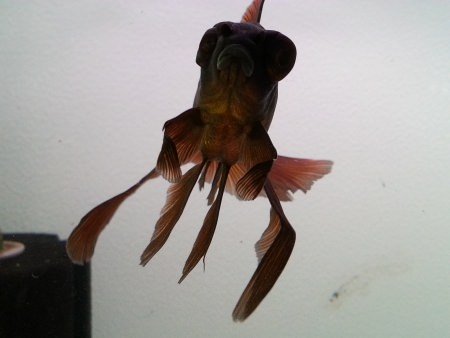| Back to Back Issues Page |
 |
|
The Goldfish Gazette, Issue #098 Genetic Diversity February 27, 2022 |
Goldfish Care TipsA Free Monthly Resource For Goldfish Enthusiasts In This Issue If you are breeding your Goldfish to improve their quality or replace aging fish, you will need to inbreed successive generations, but over time this can lead to reduced vigor and spawning problems. Genetic Diversity
Black Moor with folded pectoral finsAs we know, Goldfish have been selectively bred for 1000 years. During those centuries varieties were developed that have now been established for centuries.To maintain or improve those varieties fish have been inbred leading to smaller and smaller gene pools, and the more developed the variety, the smaller the gene pool. My latest Water Bubble Eye spawns are testament to the small gene pool in my own Country, where importing Goldfish has been prohibited for 30+ years. The first spawn was infertile, and the second spawn showed a high level of fry faults such as failure to develop swim bladders. The problem for breeders is the necessity to inbreed to develop high-quality fish. Inbreeding to Improve Fish QualityAs Izhak Kroshinsky, a well-respected breeder of exceptional Ranchu in America has written “Inbreeding is the only way to achieve good, consistent results in Ranchu breeding. One may get lucky and obtain very good fish out of a cross of unrelated fish or even an uncontrolled spawn of poor-quality fish, but following spawns will be poor and completely undependable.”Inbreeding, which I prefer to call line breeding, entails breeding the best fish from a spawning back to the parent or parents that have the traits you are looking for. For clarification, this applies to all varieties, not just Ranchu. Grandparent InfluenceThe reason we need to line breed is because it is the grandparents that have the most impact on the quality of fry, not the parents. This is why as Izhak has described, you may be lucky and get very good fish from a spawn from fish of unknown parentage, but the quality of fish from subsequent spawns will probably be poor.I was reminded of this with my successful Water Bubble Eye spawn. Normally, 5-8% of fry from my spawns have single tails. With the Bubble Eye spawn, I had 56% with single or faulty caudal fins, a massive number. I then remembered that although the parents have fully divided caudal fins, the grandparents have single tails. A surprise was the quality of the backs. In the past, I have culled 40-50% for spikes, partial dorsals, and lumpy back profiles. Of the 120 left after the first cull for faulty caudal fins, I culled one fish for a very poor back profile. This shows line-breeding in action, with the traits of the grandparents, both good and bad, coming through. Outcrossing to Deepen Gene PoolOutcrossing means breeding your fish with fish from another strain to deepen the gene pool. Again, quoting Izhak Kroshinsky, “A one-time outcross is enough to achieve this (reintroduce vigor). The penalty is that some undesirable characteristics may be introduced, which will then have to be worked out of the strain.”I experienced exactly this when I purchased a few hundred Black Moor fry from another breeder. As the fry started developing fins, I noticed a number had folded pectoral fins. This should have rung warning bells. I only selected juveniles to keep that were not exhibiting this fault. Unfortunately, as the fish reached maturity four of the six developed folded pectoral fins, two badly, two with a slight fold of one fin. I have bred the one good female and one with the least folded pectoral back to my original males, and so far, the now juvenile fish aren’t showing problems with their pectoral fins. I will grow on the last 40 fish I have kept until I am sure they aren’t going to develop folded pectoral fins, but I am sure that gene will resurface in future spawns. Comments? Ideas? Feedback? I'd love to hear from you. Just reply to this e-zine and tell me what you think, or what topics you want to be covered. Next Month's Topic Aquaponics in Pondswww.facebook.com/aboutgoldfish |
| Back to Back Issues Page |
